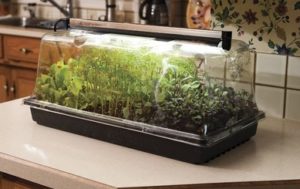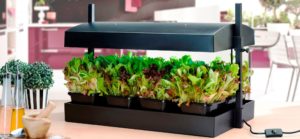Seed Starting Using Growlights
Growing from seed is one of the most gratifying gardening endeavors you’ll ever experience, and a great way to expand the variety of plants in your organic garden. One of the easiest and most effective ways is to use growlights. You can start your seeds anywhere indoors, even in a dark basement, because the growlights will provide all the light you need. Our growlights provide full spectrum lighting which your plants need, imitating natural sunlight.
Make sure the container you select for starting seeds is at least one or two inches deep and has drainage holes. The 1020 trays we supply are ideal for this purpose. The potting medium should be fast draining, yet hold water. The soil should be loose and contain vermiculite, perlite, or other aeration and water retention ingredients. Many gardeners prefer to use a seed-starting growing medium specifically formulated for seed-starting. Make sure that the soil is moist and the container is in a warm environment (anywhere indoors) before planting your seeds. Use warm water and give the soil mix time to absorb plenty of moisture. You’ve added enough water when the mix holds together when squeezed without dripping.
 At this point, the proper conditions exist for germination which can be stopped by lack of moisture, warmth, or light. It is time to plant your seeds. The seed packets will provide specific instructions about how deep to plant your seeds, but as a general rule-of-thumb the smaller the seed, the shallower the planting. Once the seeds have been placed into the soil or growing medium water gently about once a day using a gentle mist sprayer. It is important that the soil remains moist, but not in standing water. If you use a Nanodome you don’t need to water as frequently because the moisture is trapped by the greenhouse effect.
At this point, the proper conditions exist for germination which can be stopped by lack of moisture, warmth, or light. It is time to plant your seeds. The seed packets will provide specific instructions about how deep to plant your seeds, but as a general rule-of-thumb the smaller the seed, the shallower the planting. Once the seeds have been placed into the soil or growing medium water gently about once a day using a gentle mist sprayer. It is important that the soil remains moist, but not in standing water. If you use a Nanodome you don’t need to water as frequently because the moisture is trapped by the greenhouse effect.
Next Steps
Once your seeds have sprouted, room temperature is ideal. A sprouted seed is no longer a seed but a seedling, a miniature plant. The most important thing to consider and deliver is adequate plant light. Seedlings need more light than full grown plants, ideally as much as 16-18 hours a day. Once seedling emerge bring the growlight as close to the plants as possible. Keep a close eye on growth and move the lights up as they progress.
No fertilizer is necessary from the time you plant the seeds until they begin to germinate and grow. Everything a plant needs to grow is contained in the seed itself. Once the seedlings develop their first set of leaves, fertilize with a mild 1/4 to 1/2 strength-solution of liguid organic fertilizer every ten to fourteen days. If you plant your seeds in prepared seed-starting medium, there is no need to add additional fertilizer.
 Once they have grown sufficiently, you can transplant the seedlings into growing containers or 1020 trays, spacing them a little further apart. The best time to transplant seedlings is when they begin to develop true leaves. It is usually best to wait till the seedling produces its second set of leaves. Gently lift the seedling from its original container getting as much of the root system with the soil around it as possible. We found a simple way is to place the bottoms of paper egg cartons in the seedling trays before filling them with soil, and transplant while keep the seedling inside the original cavity of the egg carton. They will still need to be under growlights at this point. The ideal product to use at this point is a growlight garden which has its own capillary (or wicking) watering system, and allows for adjustment in the proximity of the light to the plants.
Once they have grown sufficiently, you can transplant the seedlings into growing containers or 1020 trays, spacing them a little further apart. The best time to transplant seedlings is when they begin to develop true leaves. It is usually best to wait till the seedling produces its second set of leaves. Gently lift the seedling from its original container getting as much of the root system with the soil around it as possible. We found a simple way is to place the bottoms of paper egg cartons in the seedling trays before filling them with soil, and transplant while keep the seedling inside the original cavity of the egg carton. They will still need to be under growlights at this point. The ideal product to use at this point is a growlight garden which has its own capillary (or wicking) watering system, and allows for adjustment in the proximity of the light to the plants.
Transplanting into the Garden
If everything goes as planned, your seedlings should be ready to transplant into your outside garden or patio growing containers in about 5 to 10 weeks from seed-starting. However, don’t just abruptly transplant them outdoors. It’s better to gradually introduce them to the great outdoor environment. Start with a few outings of just a couple hours during the warmest part of the day. Then gradually add hours until they’ve acclimated, or hardened-off, and can be planted into your garden.
If you can, transplant the seedlings into your well-prepared garden soil on an overcast day or early in the morning or evening, when the sun is not too strong. Remove the tender seedlings carefully from their containers, taking care to disturb the root ball as little as possible. Plant them one at a time in a pre-dug hole (about twice the size of the root ball), press the soil down firmly around the roots. Water immediately with a gentle mist spray and keep your seedlings evenly moist for one to two weeks after planting.
Starting your seedlings indoors with the help of growlights will give you a head start on directly seeded gardens, and the plants will mature earlier, which is a good thing if you live in an area with a short growing season. Healthy seedlings are predictable and almost always guarantee uniform plantings, while direct garden seeding can result in poor germination and gaps in rows if conditions are less than favorable.
Enjoy the wonder of seeing dormant seeds spring to life and grow into life-giving plants, right from your home to your own garden!

